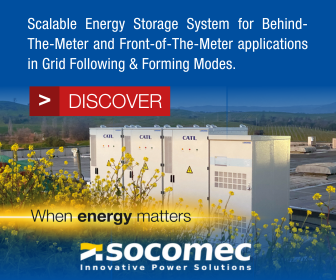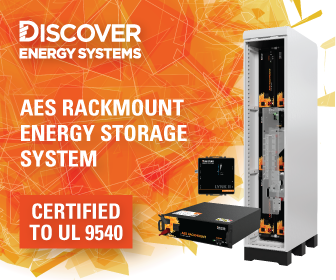Beyond Lithium: Renewable energy reliability delivered with CHS Silicon anode batteries
 A significant inhibitor to the rapid adoption of wind and solar power, both of which are only available intermittently, is greater energy storage capacity than what is currently possible. A promising response to this challenge involves the utilization of a development called cyclohexasilane ("CHS"), a silicon derivative with the capability to greatly exceed the storage capacity of current generation lithium batteries.
A significant inhibitor to the rapid adoption of wind and solar power, both of which are only available intermittently, is greater energy storage capacity than what is currently possible. A promising response to this challenge involves the utilization of a development called cyclohexasilane ("CHS"), a silicon derivative with the capability to greatly exceed the storage capacity of current generation lithium batteries.
Simply put, chemistries of today's lithium-ion batteries have reached their limitations in energy density and cycle life. In order to integrate renewables within the grid in a sustainable way, improved batteries are needed. New silicon advancements, including CHS, are creating generation 2.0 solutions that address these concerns while delivering a cost-effective solution.
Emerging Opportunity
Renewable energy has taken a larger stake in North America's power generation sector, accounting for approximately 18 percent of all electricity produced in the U.S. Even individual states are pushing renewables and setting forth new limits around carbon emissions, such as the Climate Mobilization Act in New York City. With declining costs and the newfound availability of energy storage technologies, the time is right for the rise of renewables to meet the growing public support for a solar and wind-driven power grid.
 To respond to increased pressure to incorporate more renewables, utilities need to introduce gen 2.0 batteries as quickly as possible so they can be integrated into existing operations over the next few years. Having these large-scale battery solutions will make intermittent energy resources more consistent, reliable, and - most importantly - cost effective.
To respond to increased pressure to incorporate more renewables, utilities need to introduce gen 2.0 batteries as quickly as possible so they can be integrated into existing operations over the next few years. Having these large-scale battery solutions will make intermittent energy resources more consistent, reliable, and - most importantly - cost effective.
Over the past five years, access to energy storage for residential-level solar installations has become more prevalent. While progress has been made on the residential side, innovation is still needed to create next generation batteries that are reliable and cost-effective for use in grid-scale energy storage.
Demands of Grid-Scale Storage
Grid-scale batteries have more stringent requirements compared to those used in mobile devices and electric vehicles (EVs). These batteries are constantly being used to store intermittent and unreliable resources, gathering energy when it's available and distributing it when the sun isn't shining or wind isn't blowing. Software helps, of course, but suchcontinuous charge/discharge cycles accelerate battery degradation in capacity and lifespan, far below what utilities require (which is to last many years in the field).
Gen 2.0 batteries for grid-scale renewable energy generation plants need to be able to address these longevity concerns and withstand the constant charge and discharge cycles that occur. The focus area for these improvements is the chemistry of the lithium-ion battery anode, and the introduction of new materials to improve charging, cycle life, and capacity of the battery.
Of the new materials and manufacturing processes in development to improve the lithium-ion battery, the most promising is improvement to the battery anode. Historically, lithium-ion batteries have relied on graphite for their anode. Unfortunately, graphite has not been a sufficient option (even for mobile devices) and cannot serve the needs of a mission-critical power grid. Lithium-ion batteries need a new anode material that doesn't just last longer, but also stores enough energy to meet demand.

Supercharging Battery Anodes with Silicon
Replacing the graphite anode with silicon (in the form of silicon quantum dots, nanowires, or printed structures) can unlock the capacity the power grid desperately needs. Select silicon materials have the potential to improve the lithium-ion anode by up to 400 percent. Storing 400 percent more lithium-ions in the anode means higher power density and use per charge/discharge, which results in more solar or wind energy used in the grid.
 When introduced to today's generation 1.0 lithium batteries, silicon can only improve capacity 5-10 percent without causing detrimental swelling and cracking of the battery anode (due to storing an increased quantity of lithium ions). This, in turn, decreases battery lifespan. Generation 2.0 lithium-ion batteries will develop new ways to introduce different forms of silicon, including CHS, to store more lithium-ions in an amorphous matrix, mitigating these negative results while enabling higher power densities.
When introduced to today's generation 1.0 lithium batteries, silicon can only improve capacity 5-10 percent without causing detrimental swelling and cracking of the battery anode (due to storing an increased quantity of lithium ions). This, in turn, decreases battery lifespan. Generation 2.0 lithium-ion batteries will develop new ways to introduce different forms of silicon, including CHS, to store more lithium-ions in an amorphous matrix, mitigating these negative results while enabling higher power densities.
CHS packs six times more silicon atoms per molecule compared to monosilane or SiO2, which are both commonly used today. However, using CHS as a low temperature silicon precursor can not only increase the silicon atoms within a battery anode up to 100 percent, but enable amorphous structures - extra space for lithium atoms to be stored - which are needed to manage the swelling during charges/discharges. CHS silicon anodes show the highest potential to maximize energy density and charge cycling simultaneously. CHS quantum dots and nanowires are also being evaluated, and are readily manufactured using this innovative material as the silicon precursor.
Next generation lithium-ion batteries with silicon anodes will allow us to unlock the potential of renewables within the power grid. Silicon material advancements, such as utilizing CHS, will ensure these batteries meet the capacity and reliability demands of the grid. To achieve "net zero", utilities must look beyond what is available today. The industry must invest in, and introduce gen 2.0 batteries with the enhanced silicon materials and structures needed for the prevalent use of wind and solar power.
Michael Kraft is CEO of The Coretec Group, which develops innovative technology for energy storage, solar, solid state lighting, printable electronics, and 3D displays.
The Coretec Group | www.thecoretecgroup.com
Author: Michael Kraft
Volume: 2020 September/October











